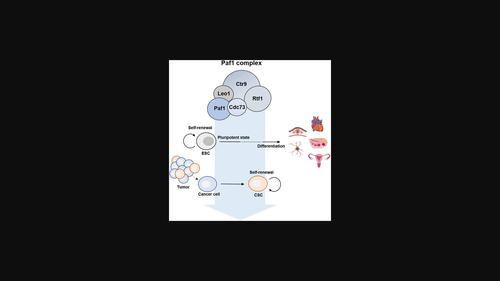Our official English website, www.x-mol.net, welcomes your
feedback! (Note: you will need to create a separate account there.)
Role of the Paf1 complex in the maintenance of stem cell pluripotency and development
The FEBS Journal ( IF 5.5 ) Pub Date : 2022-07-22 , DOI: 10.1111/febs.16582
Jiyeon Park 1 , Shinae Park 1 , Jung-Shin Lee 1
The FEBS Journal ( IF 5.5 ) Pub Date : 2022-07-22 , DOI: 10.1111/febs.16582
Jiyeon Park 1 , Shinae Park 1 , Jung-Shin Lee 1
Affiliation

|
Cell identity is determined by the transcriptional regulation of a cell-type-specific gene group. The Paf1 complex (Paf1C), an RNA polymerase II-associating factor, is an important transcriptional regulator that not only participates in transcription elongation and termination but also affects transcription-coupled histone modifications and chromatin organisation. Recent studies have shown that Paf1C is involved in the expression of genes required for self-renewal and pluripotency in stem cells and tumorigenesis. In this review, we focused on the role of Paf1C as a critical transcriptional regulator in cell fate decisions. Paf1C affects the pluripotency of stem cells by regulating the expression of core transcription factors such as Oct4 and Nanog. In addition, Paf1C directly binds to the promoters or distant elements of target genes, thereby maintaining the pluripotency in embryonic stem cells derived from an early stage of the mammalian embryo. Paf1C is upregulated in cancer stem cells, as compared with that in cancer cells, suggesting that Paf1C may be a target for cancer therapy. Interestingly, Paf1C is involved in multiple developmental stages in Drosophila, zebrafish, mice and even humans, thereby displaying a trend for the correlation between Paf1C and cell fate. Thus, we propose that Paf1C is a critical contributor to cell differentiation, cell specification and its characteristics and could be employed as a therapeutic target in developmental diseases.
中文翻译:

Paf1 复合物在维持干细胞多能性和发育中的作用
细胞身份由细胞类型特异性基因组的转录调控决定。Paf1 复合物 (Paf1C) 是一种 RNA 聚合酶 II 相关因子,是一种重要的转录调节因子,不仅参与转录延伸和终止,还影响转录偶联的组蛋白修饰和染色质组织。最近的研究表明,Paf1C 参与干细胞和肿瘤发生中自我更新和多能性所需基因的表达。在这篇综述中,我们重点关注了 Paf1C 作为细胞命运决定中的关键转录调节因子的作用。Paf1C 通过调节 Oct4 和 Nanog 等核心转录因子的表达来影响干细胞的多能性。此外,Paf1C 直接结合靶基因的启动子或远距离元件,从而维持源自哺乳动物胚胎早期的胚胎干细胞的多能性。与癌细胞相比,Paf1C 在癌症干细胞中上调,表明 Paf1C 可能是癌症治疗的靶点。有趣的是,Paf1C 参与了多个发育阶段果蝇、斑马鱼、小鼠甚至人类,从而显示出 Paf1C 与细胞命运之间相关性的趋势。因此,我们提出,Paf1C 是细胞分化、细胞特化及其特征的关键贡献者,可用作发育性疾病的治疗靶点。
更新日期:2022-07-22
中文翻译:

Paf1 复合物在维持干细胞多能性和发育中的作用
细胞身份由细胞类型特异性基因组的转录调控决定。Paf1 复合物 (Paf1C) 是一种 RNA 聚合酶 II 相关因子,是一种重要的转录调节因子,不仅参与转录延伸和终止,还影响转录偶联的组蛋白修饰和染色质组织。最近的研究表明,Paf1C 参与干细胞和肿瘤发生中自我更新和多能性所需基因的表达。在这篇综述中,我们重点关注了 Paf1C 作为细胞命运决定中的关键转录调节因子的作用。Paf1C 通过调节 Oct4 和 Nanog 等核心转录因子的表达来影响干细胞的多能性。此外,Paf1C 直接结合靶基因的启动子或远距离元件,从而维持源自哺乳动物胚胎早期的胚胎干细胞的多能性。与癌细胞相比,Paf1C 在癌症干细胞中上调,表明 Paf1C 可能是癌症治疗的靶点。有趣的是,Paf1C 参与了多个发育阶段果蝇、斑马鱼、小鼠甚至人类,从而显示出 Paf1C 与细胞命运之间相关性的趋势。因此,我们提出,Paf1C 是细胞分化、细胞特化及其特征的关键贡献者,可用作发育性疾病的治疗靶点。

































 京公网安备 11010802027423号
京公网安备 11010802027423号